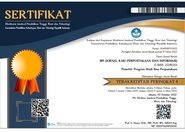ALTERNATIVE CLASSIFICATION FOR ELEMENTARY SCHOOL LIBRARIES: A NARRATIVE LITERATURE REVIEW
Abstract
Keywords
Full Text:
PDFReferences
Chung, Y. K., & Mi-Hwa. (2021). Call Numbers with Collection Codes at Children’s Libraries. Journal of the Korean Biblia Society for Library and Information Science, 20(1), 23–38.
Clarke, R. I. (2021). Library Classification Systems in the U.S.: Basic Ideas and Examples. Cataloging & Classification Quarterly, 59(2–3), 203–224.
Cooper, L. (1996). Problems Associated with the Ability of Elementary School Children to Successfully Retrieve Material in the School Library Media Center and Some Alternative Methods of Classification Which May Help to Alleviate These Problems: A Case Study of The Common School Library, Amherst, Massachusetts. Public & Access Services Quarterly, 2(1), 47–63.
Cooper, L. (1997). The Retrieval of Information in an Elementary School Library Media Center: An Alternative Method of Classification in The Common School Library, Amherst, Massachusetts. Public & Access Services Quarterly, 2(3), 1–24.
Dethan, S., & Mayesti, N. (2022). Penggunaan Dewey Decimal Classification oleh Perpustakaan Akademik di Indonesia. Jurnal Ilmu Perpustakaan (JIPER) FISIP UMMAT, 4(2), 115–122.
Ebidor, L.-L., & Ikhide, I. G. (2024). Literature Review in Scientific Research: An Overview. East African Journal of Education Studies, 7(2), 179–186.
Harati, H., & Kaffashan-Kakhki, M. (2019). The Comparison of Library Classification Systems: A Survey of the Viewpoint of Professors and Librarians. Libri, 54(4), 256–265.
Hjørland, B. (1998). Theory and metatheory of information science: A new interpretation. Journal of Documentation. Journal of Documentation, 54.
Hjørland, B. (2008). Core classification theory: A reply to Szostak. Journal of Documentation, 64, 333–342.
Hoffman, J. (1999). The color-coded catalog: One school’s experience with a classification system for young readers. School Library Journal, 45(2), 28–32.
Houston, C. R. (2008). The Use of Reading Levels as Alternative Classification in School Libraries. Cataloging & Classification Quarterly, 45(4), 65–80.
Izuchukwu, A., Nwachukwu, V., & Furfuri, I. (2021). Organization of school library resources using in-house classification schemes. Library Philosophy and Practice, 701–717.
Lacruz, M. del C. A., Fujita, M. S. L., & Terra, A. L. (2013). INDIZAR, CLASIFICAR Y ORGANIZAR LAS COLECCIONES DE LAS BIBLIOTECAS ESCOLARES: herramientas en lengua española y portuguesa. II Congreso ISKO España y Portugal / XII Congreso ISKO España, 701–717.
Lund, B., Agbaji, D., Tijani, S., & Omame, I. (2019). Evaluating Knowledge Organization in Developed and Developing Countries: A Comparative Analysis of Dewey Decimal and Library of Congress Classification Scheme Preference and use in the United States and Nigeria. Technical Services Quarterly, 36(3), 249–268. https://remote-lib.ui.ac.id:2075/10.1080/07317131.2019.1621563
Majumder, A. J., & Sarma, G. K. (2007). WebDewey: The Dewey Decimal Classification in the Web. Convention PLANNER 2007, 147–153. https://doi.org/https://www.researchgate.net/publication/317379274_WebdeweyThe_Dewey_Decimal_Classification_in_The_Web
Martínez-Ávila, D., San Segundo, R., & Olson, H. A. (2014). The Use of BISAC in Libraries as New Cases of Reader-Interest Classifications. Cataloging & Classification Quarterly, 52(2), 137–155.
Melvil, D. (1876). A classification and subject index, for cataloguing and arranging the books and pamphlets of a library. Mass.
Nesset, V. (2013). A Look at Classification and Indexing Practices for Elementary School Children: Who Are We Really Serving?. Proceedings of the Annual Conference of CAIS Actes Du Congrès Annuel De l’ACSI.
Pinheiro, Mariza. (2009). Clasificao em Cores: Uma Metodologia Inovadora na Organização das Bibliotecas Escolares do Município de Rondonópolis-MT. RDBCI: Revista Digital de Biblioteconomia e Ciência Da Informação.
Satija, MP., & Kyrios, A. (2023). A Handbook of History, Theory and Practice of the Dewey Decimal Classification System. Facet.
Schoppert, A. (2014). A Review of the Literature on Elazar’s Classification System for Libraries of Judaica. Cataloging & Classification Quarterly, 52(4), 422–430.
Skelly, M., Duong, A., Simunovic, N., & Ayeni, O. R. (2019). Type of Review and How to Get Started. Springer.
Ubillo Venega, A. (2005). Clasificación por colores en biblioteca para niños : proponiendo el código junior en colores.
DOI: http://dx.doi.org/10.30829/jipi.v10i2.25986
Refbacks
- There are currently no refbacks.
Copyright (c) 2025 Bobby - Prabowo, Wiwit Ratnasari

This work is licensed under a Creative Commons Attribution-ShareAlike 4.0 International License.










.png)

